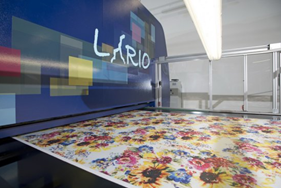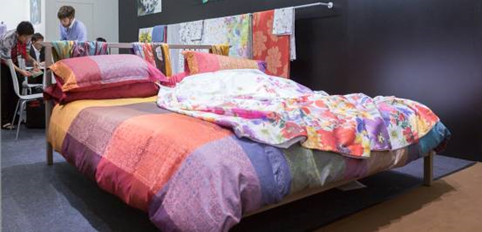 Why is digital textile printing such a big deal? First of all, there is a big practical aspect to it. Regular fabric patterns are created through rotary or flatbed screen printing that require individual screens for every color used and large yardage. Simply put, you need to print a lot of fabric and waste a lot of time and you would still be restricted in your choices. With fashion changing on the fly and consumers vying for more exclusivity and customization the scope of digital printing is on the rise.
Why is digital textile printing such a big deal? First of all, there is a big practical aspect to it. Regular fabric patterns are created through rotary or flatbed screen printing that require individual screens for every color used and large yardage. Simply put, you need to print a lot of fabric and waste a lot of time and you would still be restricted in your choices. With fashion changing on the fly and consumers vying for more exclusivity and customization the scope of digital printing is on the rise.
Another point evidencing the growing interest towards digital textile printing is the number of knowledge transfer events being planned in 2014 & 2015 by various organizations around the world including FESPA, WTiN, IMI, ESMA & Inkjet Forum India. The recently organized 3rd international digital textile congress organized by Unitex & University of Gent emphasized the point that "The Change is Clear: Analog to Digital". This was very well received and attended event with over 250 delegates & 24 speakers from US, Europe & Asia. The response received for this conference re-emphasizes interest towards digital textile printing. The delegates included a good mix of technology providers, brand owners, printing houses, print buyers, designers & academicians creating an excellent networking & learning opportunity.
Global production of digitally printed textiles is growing at an annual rate of 25 percent and at present, digitally printed textiles account for just 2 percent of total printed textile production worldwide and are expected to account for 5 percent share by 2017.
According to recent technology developments, increased adoption of digital textile printing and industry sentiment this disruptive technology is poised for a second wave. The key points driving this change can be divided into two main categories:
 Market Factors
Market Factors
- Increase in production in European countries driven by the fact that some European textile companies are looking to reshore a proportion of their production operations from developing countries to European countries in order to satisfy local tastes, facilitate quick response (QR) manufacturing and release a greater number of collections each year.
- The success of the fast fashion concept by the likes of Inditex Group, H & M & others.
- Opportunities for expansion in the luxury apparel segment as digital textile printing enables retailers of luxury apparel to produce small quantities of high quality, limited edition pieces cost efficiently.
- Further scope for expansion lies in the area of mass customization, whereby a consumer is able to personalize a product by choosing a design on a dedicated web page in a retailer's online store for subsequent production by a digital textile printer.
Technology Factors
- Development & improvement of printing technology with high speed single pass printing capabilities matching the speeds of rotary screen printing. A recent example being the MS Lario which has seen early success with installations at high profile fashion and home textile companies. ITMA 2015 later next year in Milan will also see launches of high speed single pass printers from SPG Prints and other leading OEMs.
- Decline in pricing of digital textile inks due to efficient sourcing and improved manufacturing processes leading to the overall cost-effectiveness of the technology.
- Interest from the Home Textile industry to adopt digital textile printing with ready availability of stable wider width printers to enable printing bed sheets, curtains, etc. This would get an additional push with the increasing availability of pigment inks for high speed roll to roll printing at an industry acceptable price point which is key for the home textile industry.
Additionally recent investments & acquisitions in the digital textile sector could provide a fillip to the entire sector pushing for further innovative products & services. Now we have to wait and watch if ITMA 2015 replicates ITMA 2003 and acts as a catalyst giving momentum to the second wave in digital textile printing.
www.inkjetforumindia.com





























































































